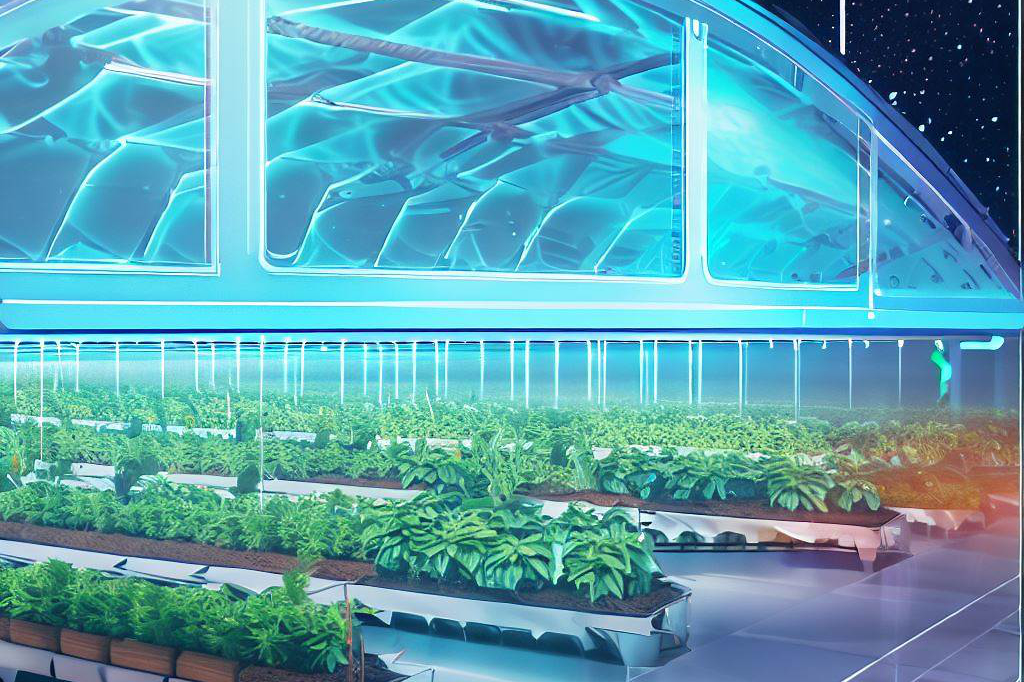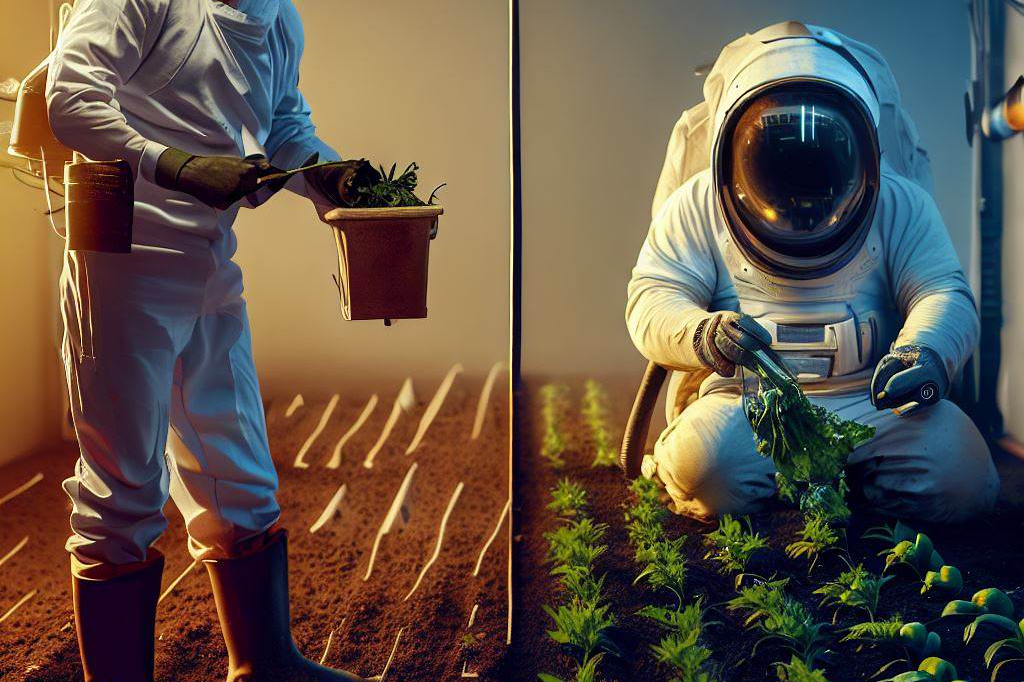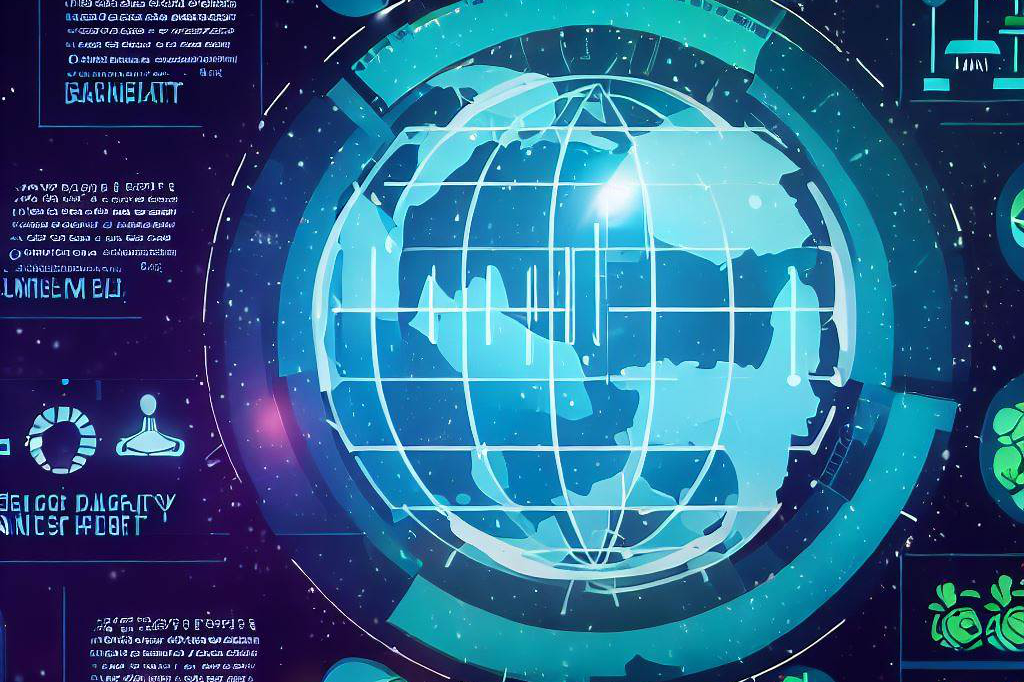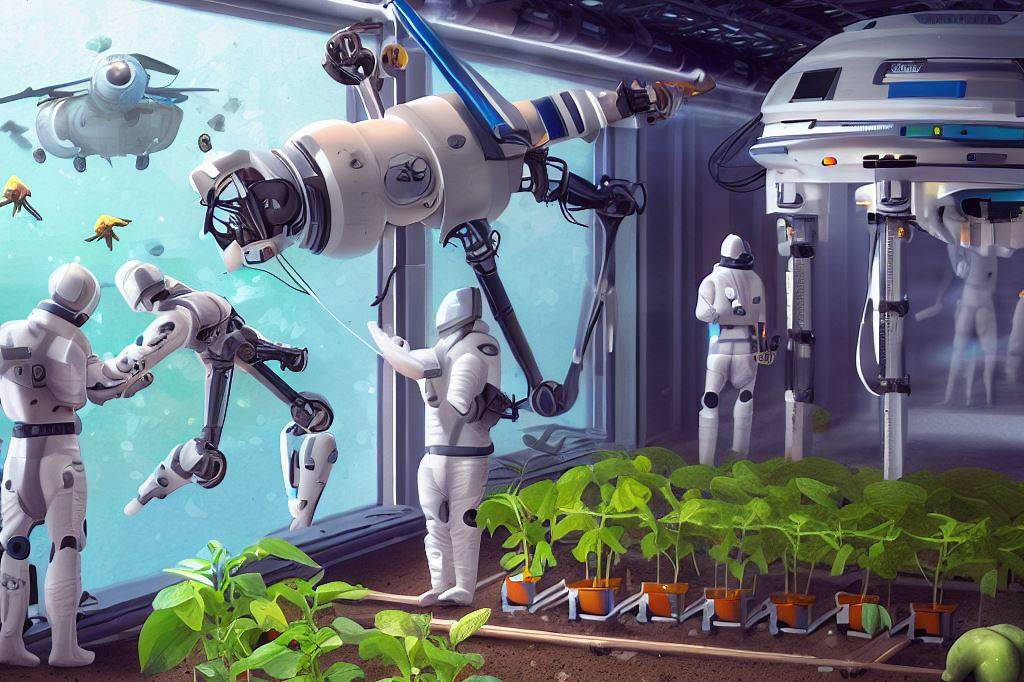Brief overview of global food security challenges
In a world with a growing population, it is becoming increasingly challenging to provide enough food to meet the needs of everyone. The United Nations estimates that by 2050, the global population will reach almost 10 billion people. This means that we will need to produce 70% more food than we currently do today.
However, climate change and environmental degradation are affecting agricultural productivity in many regions of the world, exacerbating the problem of food security. Food insecurity is not only a problem in developing countries but also in developed ones.
In the United States alone, over 37 million people experienced food insecurity in 2018, according to Feeding America. In addition to hunger and malnutrition, inadequate access to affordable and nutritious food can lead to long-term health problems such as obesity and diabetes.
The potential of space-based agriculture and food production

Space-based agriculture has recently emerged as a promising solution for addressing global food security challenges. By using controlled environments and advanced technologies such as hydroponics and aeroponics, it is possible to grow crops in space with minimal dependence on weather conditions or soil quality.
NASA’s Veggie experiment on board the International Space Station (ISS) has already produced lettuce crops that were sent back down to Earth for consumption by astronauts. China’s Lunar Palace project aims to establish sustainable life support systems, including crop growth on the moon, through regenerative technology.
However, space-based agriculture faces many challenges, such as high costs for technology and infrastructure development; limited access to space for agricultural purposes; ethical concerns regarding genetically modified crops; among others. Despite these challenges, though, there is great promise for this emerging field – a potential game-changer for global food security.
Advantages of Space-Based Agriculture
Ability to Grow Crops in a Controlled Environment

One major advantage of space-based agriculture is the ability to control the growing conditions of crops, which can lead to higher yields and better quality produce. By controlling factors such as temperature, humidity, light intensity, and carbon dioxide levels inside a closed environment, scientists can create ideal growing conditions for plants.
This allows crops to be grown year-round without dependence on seasonal changes or weather patterns. The controlled environment also enables researchers to experiment with different plant varieties and growing techniques.
No Dependence on Weather Conditions
Traditional agriculture is highly dependent on weather patterns, which can cause crop failures due to droughts, floods, or extreme temperatures. In contrast, space-based agriculture eliminates the unpredictability of weather conditions by providing a stable environment for plant growth. This means that food production would be less vulnerable to natural disasters caused by climate change.
Increased Crop Yield and Quality
Space-based agriculture has the potential to increase crop yields by up to 50% compared to traditional farming methods. This is because plants are grown in optimal conditions with access to all necessary resources, such as water and nutrients. Additionally, produce grown in space has been shown to have a higher nutritional value due to increased exposure to light and fewer contaminants from pesticides or pollutants.
Reduced Use of Pesticides and Herbicides
Space-based agriculture could significantly reduce the need for harmful chemicals like pesticides and herbicides used in traditional farming methods. By controlling the growing environment, it becomes easier to prevent pests from infesting crops while also minimizing weed growth through careful management practices.
This not only makes produce healthier for humans but also reduces environmental pollution caused by agricultural chemicals entering soil and water systems. Overall, space-based agriculture provides many benefits over traditional farming methods that will help address global food security challenges.
Current space-based agriculture initiatives
The International Space Station’s Veggie experiment

One of the most notable current space-based agriculture initiatives is the Veggie Experiment, which was implemented on the International Space Station (ISS) in 2014. The experiment aims to determine whether plants can be grown successfully in space using red, blue, and green LED lights.
The first crop grown in this experiment was lettuce, which was harvested and consumed by astronauts aboard the ISS. The success of this experiment has paved the way for further research into growing crops that could potentially supplement astronauts’ diets during long-term space missions.
China’s Lunar Palace 1 project
In 2018, China launched a groundbreaking project called Lunar Palace 1 with the aim of developing a self-sustaining ecosystem that could support human life on long-term missions to the Moon or Mars. This project involved growing crops such as wheat, potatoes, and cabbages inside a sealed environment where temperature and humidity could be carefully controlled.
Additionally, researchers are studying how to recycle waste products into fertilizers that can be used to grow more crops. Although still in its early stages, this project represents an exciting step towards developing sustainable food production systems for future space exploration.
The Mars Farm Odyssey
Another notable initiative is The Mars Farm Odyssey (TMFO), which is led by Dutch entrepreneur Wieger Wamelink. This project aims to determine whether certain crops such as tomatoes, peas, and radishes can be grown successfully on Martian soil-like substrates called Regoliths under different environmental conditions. TMFO uses simulated Martian habitats and growing conditions inside laboratories at Wageningen University & Research Plant Sciences Group in Netherlands.
As we continue to explore deeper into outer space with longer missions planned and even the colonization of other planets like Mars becoming a reality soon — it’s clear that food supplies will play an important role in human survival. The current space-based agriculture initiatives are laying the foundation for long-term sustainable food production in extra-terrestrial environments, and could ultimately help address global food security challenges here on Earth as well.
Challenges to implementing space-based agriculture
High cost of technology and infrastructure

One major challenge facing the implementation of space-based agriculture is the high cost of technology and infrastructure. The equipment needed to grow crops in a controlled environment in space can be very expensive, and the maintenance costs can also be quite high.
This is especially concerning because many developing countries that are most affected by food insecurity may not have the resources to fund such projects. However, there are efforts underway to reduce these costs.
Advances in technology and communication have made it easier for researchers to share information about how best to grow crops in space, which could help reduce trial-and-error costs for future projects. Additionally, private companies like SpaceX are working on ways to make access to space more affordable.
Limited access to space for agricultural purposes
Another major challenge facing space-based agriculture is the limited access we currently have to space for agricultural purposes. As of now, only a handful of countries have their own launch capabilities, which means that many developing nations would need partnerships or funding from outside sources in order to participate. There are some efforts underway to address this issue as well.
NASA has been working with private companies like SpaceX and Boeing on developing commercial crew vehicles that would eventually make it easier for humans and cargo alike to get into orbit. Additionally, international cooperation through organizations like the International Space Station has helped foster collaboration between nations on scientific research projects.
Ethical concerns regarding genetically modified crops
Some critics of space-based agriculture worry about the ethics surrounding genetically modified (GM) crops being grown in a closed environment without much oversight. GM crops may offer benefits like increased yield or resistance against pests or climate conditions, but they also raise concerns about potential health risks associated with consuming them. To address these concerns, researchers working on GM crops need transparency when it comes to testing and approval processes.
Additionally, they must take into account cultural differences and ethical considerations related to growing or consuming certain crops in different parts of the world. Overall, while there are still many challenges that must be addressed before space-based agriculture can become a reality, there is hope that with continued research and collaboration between nations, we may one day be able to address global food insecurity through this innovative approach.
Potential solutions to overcome challenges
Collaboration between governments, private sector, and academia

One of the most important solutions to overcome the challenges of space-based agriculture is collaboration. Governments, private sectors, and academia can work together to pool resources and expertise towards this common goal.
For example, governments can provide funding for research and development of sustainable technologies for space-based agriculture. Private sector companies can apply their knowledge of advanced agricultural techniques to develop innovative approaches that will work in space environments.
Meanwhile, academic institutions can lend their expertise in fields such as botany, engineering, and environmental science to further our understanding of how to grow crops in space. Collaboration also extends to international cooperation between countries.
In the past, there have been successful collaborations between different nations on space missions like the International Space Station project. With this model as an example, countries can come together to build facilities that will support long-term food production in outer space.
Development of sustainable technologies for long-term space missions
Another potential solution is the development of sustainable technologies that can support long-term food production in outer space. This includes the use of hydroponic and aeroponic systems that require less water than traditional soil-based methods would need. Sustainable energy sources like solar power can be utilized as well since it could mitigate any carbon-emissions associated with conventional agriculture practices on earth.
Moreover, there’s ongoing research into developing closed-loop systems where waste products generated by astronauts or plants are recycled back into fertilizers, which could then be used again for growing crops. Developing sustainable technology is crucial because resources in outer-space are limited, so it’s critical that we don’t rely on wasteful farming methods or practices that may adversely affect fragile ecosystems.
Final Thoughts

If space-based agriculture becomes a reality in the future, it could have a tremendous impact on global food security. According to some estimates by NASA scientists and other researchers in this field, there are 8 billion people alive today; but by 2050 that number may reach 10 billion people who will need food. By growing crops in controlled environments outside of Earth’s atmosphere or even using other planets or moons as hosts for agriculture, we can meet this increasing demand.
With climate change threatening traditional farming practices around the world – especially in poorer nations – it’s important that we explore new ways of producing food that aren’t subject to weather or environmental damage like droughts or floods. Space-based agricultural practices could help us adapt better than before because they operate under much more stable conditions over time than Earth-bound farming methods do.
The idea of growing crops in outer space may seem far-fetched now, but it has already been proven successful through various experiments. Although there are many challenges to overcome, the potential benefits of space-based agriculture are too great to ignore.
The development of this technology could help us meet the growing demand for food while also minimizing the environmental impact on Earth. So let’s keep our fingers crossed and hope that in the near future, space farming will become a reality and we will be able to take one small step towards solving global food security problems!
FAQ: Space-Based Agriculture and Global Food Security
1. What is space-based agriculture?
– Space-based agriculture refers to the cultivation of crops and the rearing of livestock in space or using space-related technologies on Earth.
2. How does space-based agriculture work?
– Space-based agriculture utilizes innovative technologies such as hydroponics, aeroponics, and vertical farming to grow crops without soil, using controlled environments, artificial lighting, and optimized nutrient solutions.
– Additionally, it explores the potential of growing plants in space stations or habitats with controlled atmospheres, temperature, and humidity levels.
3. What are the potential benefits of space-based agriculture for global food security?
– Space-based agriculture offers several potential benefits for global food security. Firstly, it allows for year-round crop production and can mitigate the impact of climate change and natural disasters on traditional agriculture.
– By maximizing space utilization, it enables higher crop yields per square meter, thus increasing overall food production.
– It also reduces the dependence on traditional farmland, making it possible to grow food in urban areas and regions with limited arable land.
– Space-based agriculture can provide fresh produce to astronauts during long-duration space missions, paving the way for future human exploration of space.
4. How can space-based agriculture contribute to sustainable food production?
– Space-based agriculture aligns with the principles of sustainability by minimizing the use of resources such as water, land, and fertilizers.
– Hydroponics and aeroponics, commonly used in space-based agriculture, require significantly less water compared to traditional farming methods.
– The controlled environments in space-based agriculture also reduce the need for pesticides, herbicides, and other harmful chemicals, making it an environmentally friendly approach.
– Additionally, by integrating renewable energy sources such as solar power, space-based agriculture can further reduce its carbon footprint.
5. What are the challenges and limitations of space-based agriculture?
– Despite its potential, space-based agriculture faces several challenges and limitations. The initial setup and infrastructure costs can be substantial, requiring significant investments in research, technology development, and space missions.
– Ensuring the reliable supply of essential resources like water, nutrients, and energy in space or in remote areas on Earth can be complex and expensive.
– The lack of gravity in space poses unique challenges to plant growth, including the absence of natural air circulation and the need for artificial pollination methods.
– Furthermore, space-based agriculture is currently limited to certain types of crops and may not be suitable for staple food crops that require large-scale production.
6. How does space-based agriculture contribute to scientific research?
– Space-based agriculture serves as a platform for conducting scientific research on plant biology, crop growth, and environmental conditions in extreme environments.
– Studying plant growth in microgravity environments helps scientists understand how plants respond to different gravitational forces, which could have implications for future space exploration and colonization.
– Space-based agriculture also provides opportunities for testing and refining technologies that can be applied to terrestrial agriculture, leading to innovations and improvements in farming practices on Earth.
7. Is space-based agriculture commercially viable?
– While space-based agriculture is still in its early stages, there is growing interest from private companies and research institutions in exploring its commercial potential.
– Advances in technology, reduction in launch costs, and increasing demand for sustainable and high-quality food products are driving the commercialization efforts.
– Additionally, space-based agriculture could find applications beyond food production, such as the cultivation of medicinal plants or the production of biofuels in space.
– However, achieving commercial viability will require further advancements in efficiency, cost-effectiveness, and scalability.
In conclusion, space-based agriculture has the potential to revolutionize global food security by enabling year-round crop production, sustainable farming practices, and utilization of limited resources. While facing challenges and limitations, space-based agriculture contributes to scientific research and holds promise for commercial applications in the future.
TL;DR…
– 🌍 Space-based agriculture has the potential to revolutionize global food security.
– 🚀 It utilizes innovative technologies like hydroponics and aeroponics to grow crops without soil.
– 🌱 The controlled environments and optimized nutrient solutions enable year-round crop production.
– 💡 Space-based agriculture reduces the dependence on traditional farmland and maximizes space utilization.
– 🌿 It can contribute to sustainable food production by minimizing resource usage and reducing the need for harmful chemicals.
– 🌐 Space-based agriculture offers scientific research opportunities in plant biology and environmental conditions.
– 💰 There is growing commercial interest in space-based agriculture, driven by technological advancements and demand for sustainable food products.
– 🌌 Achieving commercial viability will require further advancements in efficiency, cost-effectiveness, and scalability.

C M, a seasoned editor, journalist, and consultant, is deeply fascinated by the convergence of technology, space, and the future of humanity.
With a particular interest in transhumanity, futurology, and the philosophical and ethical dimensions of these domains, C M serves as the lead contributor to SpaceSpotlight and TranscendSphere.
When not penning insightful articles on these rapidly evolving fields, C M indulges in their love for podcasts and books, proudly embracing their status as a ‘Happy Nerd Extraordinaire!’



